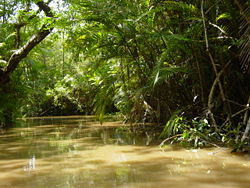The Amazon River of South America is the world's largest river and the lifeblood of the world's largest ecosystem,

spanning two-fifths of an entire continent. It is home to a huge variety of animals and plants that dwell in its lush, evergreen environment. It is the mightiest river in the world by volume, with six times greater total river flow than the next six largest rivers combined, and the most extensive drainage basin in the world. Because of its vast dimensions it is sometimes called The River Sea. Running about 4,000 miles (6,400 kilometers), most sources regard the Amazon as the second longest river in length, compared to Africa's Nile River, though this is a matter of some dispute.
Originally explored in the sixteenth century by Europeans who used the Amazon to traverse the formidable environment, the vast waterway fed by numerous tributaries eventually gave rise to commerce in later years. Utilizing boats and steamers, Europeans, slaves, and indigenous peoples increasingly carried out of the rainforest a rich array of highly sought-after products.
In recent years, a highway has made further inroads into the region, while Brazil has sought to keep the Amazon basin free from foreign exploitation. However today, the Amazon is ecologically endangered from reckless deforestation and a lack of public understanding of the importance of this remote region.
The vast Amazon[]
The area covered by the Amazon River and its tributaries more than triples between the dry season and wet season over the course of a year. In an average dry season, 110,000 square kilometers of land are water-covered, while in the wet season the flooded area of the Amazon basin rises to 350,000 square kilometers. At its widest point the Amazon River can be 6.8 miles (11 kilometers) wide during the dry season, but during the rainy season when the Amazon River floods the surrounding plains it can be up to 24.8 miles (40 kilometers) wide.
The quantity of freshwater released by the Amazon into the Atlantic Ocean is enormous: up to 300,000 square meters per second in the rainy season. The Amazon is responsible for one-fifth of the total volume of freshwater entering the oceans worldwide. Offshore of the mouth of the Amazon, potable water can be drawn from the ocean while still out of sight of the coastline, and the salinity of the ocean is notably lower a hundred miles out to sea.
The Amazon estuary is over 202 miles (325 kilometers) wide. The main river is navigable for large ocean steamers to Manaus, Brazil, more than 900 miles (1,500 kilometers) upriver from the mouth. Smaller ocean vessels of 3,000 tons can reach as far as Iquitos, Peru, 2,250 miles (3,600 kilometers) from the sea. Smaller riverboats can reach 486 miles higher as far as Achual Point. Beyond that, small boats frequently ascend to the Pongo de Manseriche, just above Achual Point.
The Amazon drains an area of some 2,722,000 square miles, or nearly 40 percent of South America. It gathers its waters from 5 degrees north latitude to 20 degrees south latitude. Its most remote sources are found on the inter-Andean plateau, just a short distance from the Pacific Ocean; and, after coursing through the interior of Peru and across Brazil, it enters the Atlantic Ocean at the equator. The Amazon has changed its drainage several times, from westward in the early Cenozoic period to its present eastward locomotion following the uplift of the Andes Mountains.